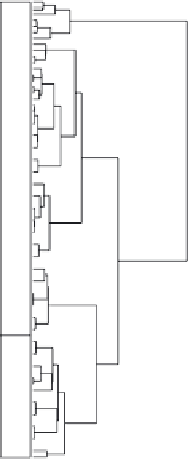Geoscience Reference
In-Depth Information
Figure 9.
Simplified pollen diagram for core HU84011-12, St. Anne
'
is Basin. Pollen zonation is that of Cape Breton. Ages
on the left side are calibrated dates based on foraminifera (asterisks) and from Cape Breton pollen records with which core
12 was correlated (greater than symbols). Lines on the right are the results of the cluster analysis.
in Betula pollen and the peak in Sphagnum percentages
between 143 and 280 cm have been correlated with zone
CP3-ii, and the top of this zone is dated at 3.23 ka. The upper
part of core 19 (0
-
150 cm) is characterized by decreasing
percentages of Betula pollen and increasing percentages of
Picea pollen, similar to zone CP4.
Pollen assemblage zone C1 (540
-
430 cm) is defined by the
maximum percentages of Pinus, the increase in Tsuga, and
by decreased proportions of shrub (Betula and Alnus) and
Abies pollen. It is also the zone where the proportion of total
Betula is the lowest.
The peak of Tsuga pollen that defines pollen assemblage
zone C2 (430
-
250 cm) suggests a warmer climate and has
been traditionally used to define the hypsithermal in Nova
Scotia [Anderson, 1985]. The beginning of the Tsuga peak is
dated at 7.98 ka in Silver Lake [Livingstone, 1968; Ogden,
1987]. Percentages of tree Betula and deciduous hardwoods
gradually increase in this zone, and Fraxinus first appears in
the middle of the zone.
Pollen assemblage zone C3 (upper 250 cm of core 12)
starts with the decline of Tsuga and is characterized by the
highest percentages of tree Betula (also total Betula) and
hardwoods. The decline of Tsuga is dated at 5.32 ka in Silver
Lake [Livingstone, 1968; Ogden, 1987]. A similar decline
was observed in pollen records from all over North America
around circa 5.45 ka [Davis, 1979]. Zone C3b records the
decline of Pinus accompanied by an increase of Tsuga and
Abies percentages. The base of zone C3b at 100 cm is dated
at 3.22 ka at Everitt Lake [Green, 1987].
5.2.2. Pollen Zones in Core 12, St. Anne
'
is Basin. Pollen
assemblages from core 12 (Figure 9) are dominated by pollen
of conifers (mainly Pinus, Picea, Abies,andTsuga)and
deciduous shrubs (Betula and Alnus) with some deciduous
tree pollen (Betula, Acer, Quercus, Fagus, Fraxinus,and
Ulmus) and herbs (Cyperaceae). Because of the similarity
between the pollen assemblages from this core and those of
onshore lake pollen records, the pollen zonation from Nova
Scotia lakes [Livingstone, 1968] is used.
Pollen assemblage zone A (745
-
550 cm) is characterized
by relatively low pollen concentrations, high percentages of
Pinus pollen, and the maximum percentages of Abies, Alnus,
and shrub Betula (Betula pollen grains smaller than 20
μ
m
are considered to represent shrub varieties [Dyer, 1986]).
Salix and herbs (Cyperaceae and Polygonaceae) are also
relatively important.














































Search WWH ::

Custom Search